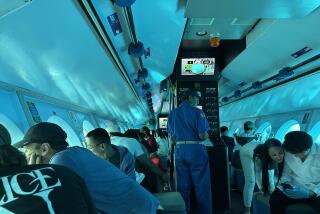Russian Disaster Stops Plan to Retire Submarine Rescue Vessel
- Share via
CORONADO — It sits in a corner of a nondescript metal-roofed building at North Island Naval Air Station.
If a 30-ton cigar-shaped hunk of steel can be said to be forlorn, the submarine rescue vehicle Avalon is downright downcast.
When it was built during the Nixon administration, it was considered a technological marvel akin to the Apollo spacecraft--a breakthrough in the Cold War undersea game of cat-and-mouse between U.S. and Soviet submariners.
A year ago, however, Navy budgeteers decided it was too old and too expensive to maintain and slated it for retirement, like an officer passed over for promotion.
But the tragedy of the Russian submarine Kursk, lost beneath the Barents Sea with 118 aboard, has given a reprieve to the Avalon, one of the U.S. Navy’s two top submarine rescue vehicles, both based here.
The Navy concluded this is not a smart time to be seen as reducing its ability to rescue U.S. submariners who someday might be trapped beneath the sea.
“In light of recent events stemming from the Kursk disaster, the Navy is reviewing possibilities [for the Avalon] short of full inactivation,” said a Pentagon statement last week. Translation: Avalon is not going to the mothball fleet.
At the headquarters of the U.S. Navy’s submarine rescue service, news of the Avalon turnaround was cause for joy.
Affection is high for Avalon among the men who have spent their careers and risked their lives taking the craft to the bottom of oceans around the globe.
“She’s a top performer,” said Lt. Cmdr. William E. Fultz, the Deep Submergence Unit’s operations officer and Avalon’s former skipper. “She takes care of you.”
When the talk turns--as it did during the Kursk drama--to the daunting challenges involved in trying to save men trapped on the ocean floor, all roads lead to a group of buildings at the far end of a base that is best known for its mighty aircraft carriers.
For 30 years, Avalon and its twin, the Mystic, have been the state of the art in submarine rescue, kept ready 24 hours a day to go anywhere in the world a U.S. submarine is in trouble.
As part of the Navy’s only submarine rescue force, the Deep Submergence Unit sailors at North Island have developed an esprit that rivals that of aviators.
“We think of ourselves as the top guns of the submarine community,” said Michael Fox, a life-support system specialist.
Many of the enlisted sailors are from the MTV generation, but the Avalon and the Mystic are from that seemingly long-ago era when American academia and industry teamed up in an atmosphere of fevered competition with the Soviets to ensure that the U.S. enjoyed a technological advantage.
The loss of the U.S. submarines Thresher in 1963 and Scorpion in 1968 had shaken the confidence of the American public. The nuclear submarines could dive to depths that far outstripped the capability of World War II-era rescue chambers.
While the Thresher and Scorpion crews--like the Kursk crews--were thought to have died instantly from a “catastrophic” event, the loss of the two subs led to soul-searching in the Navy.
“There was a lot of talk that, ‘Hey, we’re doing a lot to help pilots survive crashes with better ejection seats and things, why aren’t we doing more to help submarine crews?’ ” said Harry Mathis, a retired Navy submarine captain.
In response, Lockheed Missiles and Space Co. of Sunnyvale and the Massachusetts Institute of Technology designed a 52-foot mini-submarine that could be launched from either a “mother” submarine or a specially equipped surface ship, dock with a downed submarine at depths of several thousand feet and rescue 24 sailors per trip.
Adapting technology used on the Apollo, Lockheed and MIT had to overcome the enormous problems caused by darkness, pressure, currents and vibrations from the craft’s propellers.
“She handled very well right from the beginning,” said Larry Shumaker, the former submariner who was Lockheed’s chief test pilot on the program.
At all times, either Avalon or Mystic is ready to be loaded onto an Air Force cargo plane and taken to a friendly port for transfer to a submarine or surface ship.
Although they have done hundreds of simulated rescues--a 2,000-foot “hole” off La Jolla is a favorite training spot--Avalon and Mystic have never been called on to attempt an actual rescue. No U.S. submarine has been lost since Scorpion.
In an era of tight budgets, the Navy decided that the cost of maintaining both Avalon and Mystic was too high. The Navy has only enough equipment to transport and launch one at a time.
Also, the Navy is eager to phase in new technology.
A $20.5-million contract has been awarded to a Canadian firm to build a rescue vehicle akin to that being used by the Australian navy. The Navy is buying four diving suits at $1.5 million each to allow rescue divers to descend to 2,000 feet.
The Navy planned to retire Avalon next month and Mystic in 2005. But the specter--however remote--that a U.S. submarine might need help when Mystic is down for repairs or involved in training in a remote location has changed Pentagon thinking.
“You don’t throw away your parachute or life raft just because you’ve never had to use it,” Shumaker said.
More to Read
Sign up for Essential California
The most important California stories and recommendations in your inbox every morning.
You may occasionally receive promotional content from the Los Angeles Times.













